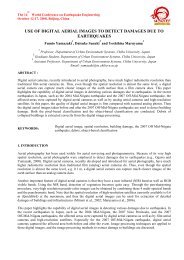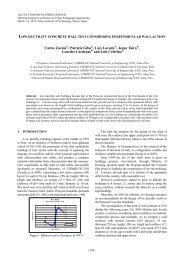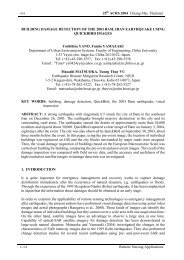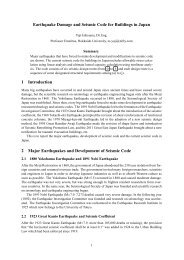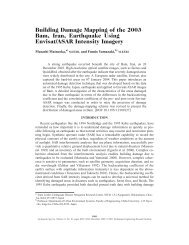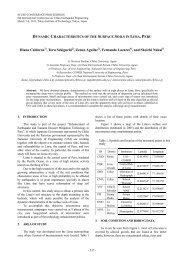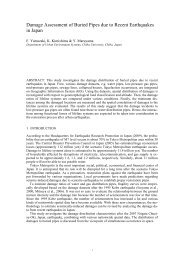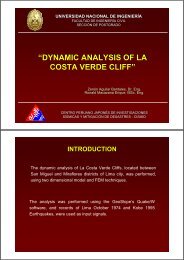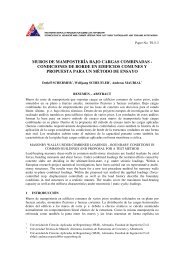Miguel A. Diaz , Koichi Kusunoki , and Akira Tasai
Miguel A. Diaz , Koichi Kusunoki , and Akira Tasai
Miguel A. Diaz , Koichi Kusunoki , and Akira Tasai
You also want an ePaper? Increase the reach of your titles
YUMPU automatically turns print PDFs into web optimized ePapers that Google loves.
estimated using the formulations of the equivalent damping<br />
<strong>and</strong> response reduction ratios presented in this paper. It is<br />
because the fundamental period of these specimens are close<br />
to the predominant period of the corresponding input<br />
waveform (KOBE-NS). Also, the specimen Frame2b could<br />
not be used because it suffered the P-Δ effect <strong>and</strong> its<br />
maximum response amplitude is larger than the elastic<br />
spectral response with damping ratio of 0.05.<br />
On the other h<strong>and</strong>, the equation of equivalent damping<br />
ratio given in Eq. (1) is developed by the geometric stiffness<br />
method which supposes that the positive <strong>and</strong> negative<br />
amplitudes of the hysteresis loop are equal. Although, as<br />
shown in Figure 6a, 6c, 7b, 7c, 7d <strong>and</strong> 7e, the hysteresis<br />
loops are shifted in many cases toward negative or positive<br />
direction, <strong>and</strong> amplitudes (negative <strong>and</strong> positive) turn out to<br />
be quite different; this shifting is intensified during<br />
aftershocks, where a residual deformation due to the<br />
mainshock may occur.<br />
Thus the energy dissipation, or equivalent damping, is<br />
represented much closer to the true value when both<br />
amplitudes, negative <strong>and</strong> positive, are used to estimate an<br />
equivalent period (peak-to-peak), <strong>and</strong> then defining the<br />
equivalent amplitude.<br />
An important characteristic is that the envelope of the<br />
spectral response during the mainshock maintains the same<br />
shape during the aftershock, but moved toward one direction<br />
or another, <strong>and</strong> the residual deformation becomes the new<br />
origin. It means the capacity curve preserves the same shape<br />
until the structure sustains major damage (large deformation).<br />
This phenomenon can be observed in Figure 9, the envelope<br />
of the response during mainshock looks like moved toward<br />
positive direction during the aftershock, <strong>and</strong> the new origin<br />
is relocated at 3.2 cm.<br />
Therefore, the equivalent damping <strong>and</strong> response<br />
reduction ratios are calculated after defining the equivalent<br />
amplitude as the intersection between the line parallel to the<br />
resulting line of joining the peak amplitudes (peak-to-peak)<br />
which crosses the origin <strong>and</strong> the negative or positive branch<br />
of the envelope of the spectral response (Figure 9a). In case<br />
of the response during the aftershock (Figure 9b), the<br />
parallel line crosses the new origin (residual deformation).<br />
After defining the equivalent amplitude, the equivalent<br />
damping ratio is calculated by reducing the dem<strong>and</strong> curve<br />
toward the equivalent amplitude, as describe in Section 2.4.<br />
Then the response reduction ratio is calculated as the ratio of<br />
the equivalent amplitude to the elastic response. The elastic<br />
response corresponds to the intersection between the parallel<br />
with the dem<strong>and</strong> spectrum with damping ratio of 0.05, as<br />
shown in Figure 9a. In case of aftershocks, the dem<strong>and</strong><br />
spectrum is moved toward the residual deformation as<br />
shown in Figure 9b.<br />
4. ANALYSIS OF RESULTS<br />
Figure 10 shows the relation between the ductility<br />
factors due to mainshocks <strong>and</strong> aftershocks, using the<br />
absolute maximum displacement (maximum amplitude),<br />
<strong>and</strong> the negative <strong>and</strong> positive maximum displacement<br />
(equivalent amplitude).<br />
a) Response during mainshock<br />
Figure 10 Relation between ductility factors<br />
b) Response during aftershock<br />
Figure 9 Estimation of parameters using the equivalent<br />
amplitude<br />
Table 2, Table 3, Table 4 <strong>and</strong> Table 5 show the ductility<br />
factor (μ), the equivalent damping ratio (h eq ) <strong>and</strong> the<br />
response reduction ratio (F h ) obtained from the experimental<br />
tests, <strong>and</strong> the estimated response reduction ratio. In order to<br />
- 1208 -





